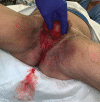Two-stage Neoscrotum Reconstruction Using Porcine Bladder Extracellular Matrix after Fournier's Gangrene
- PMID: 32983789
- PMCID: PMC7489698
- DOI: 10.1097/GOX.0000000000003034
Two-stage Neoscrotum Reconstruction Using Porcine Bladder Extracellular Matrix after Fournier's Gangrene
Abstract
Fournier's gangrene is a life-threatening infection. Survivors can be left with significant deformity of their external genitalia. We present our technique for restoring a more normal appearance to the scrotum.
Methods: A 2-stage orchiopexy and scrotoplasty are performed. At the first stage, the testicles are delivered to their anatomic place and sutured together. Xenograft powder and wound matrix are used to stimulate a granulation response. After 2-3 weeks, split-thickness skin grafting is performed to create a neoscrotum. This is protected for 1 week with negative pressure wound therapy. Postoperatively, the scrotum is protected with nonstick dressings to prevent synechiae to the perineum.
Results: Two to three weeks after product application, a robust granulation tissue bed can be seen, which is very receptive to a meshed skin graft scrotal pouch. Circumferential negative pressure wound therapy is safe and prevents synechiae of the scrotum to perineum. The scrotum healed without issue and demonstrated an acceptable aesthetic result.
Conclusions: This technique produces a near-normal appearing scrotum in the normal anatomic position for the testicles. The porcine xenograft material incites an intense granulation reaction, producing a wound bed amenable to accept a skin graft at 2-3 weeks. This 2-stage procedure to create a neoscrotum can be considered for the reconstruction of disfigured genitalia from Fournier's gangrene wounds.
Copyright © 2020 The Authors. Published by Wolters Kluwer Health, Inc. on behalf of The American Society of Plastic Surgeons.
Figures







References
-
- Fournier AJ. Gangrene foudroyante de la verge. Semaine Med. 1883;3:345
-
- Sarani B, Strong M, Pascual J, et al. Necrotizing fasciitis: current concepts and review of the literature. J Am Coll Surg. 2009;208:279. - PubMed
-
- Paty R, Smith AD. Gangrene and Fournier’s gangrene. Urol Clin North Am. 1992;19:149–162 - PubMed
-
- Chabak H, Rafik A, Ezzoubi M, et al. Reconstruction of scrotal and perineal defects in Fournier’s gangrene. Modern Plast Surg. 2015;5:23–27
-
- Ferreira PC, Reis JC, Amarante JM, et al. Fournier’s gangrene: a review of 43 reconstructive cases. Plast Reconstr Surg. 2007;119:175–184 - PubMed
LinkOut - more resources
Full Text Sources
